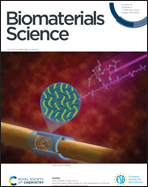Self-adaptive antibacterial surfaces with bacterium-triggered antifouling-bactericidal switching properties†
Abstract
Catheter-induced infection is a severe problem in clinical practice, which induces significant morbidity, mortality and treatment costs. Therefore, there is a great requirement for developing antibacterial surfaces of catheter materials. In the present study, we develop a strategy for constructing self-adaptive antibacterial surfaces with bacterium-triggered antifouling-bactericidal switching properties on polyurethane (PU) via surface-initiated atom-transfer radical polymerization (SI-ATRP). Polymer coating with one hierarchical structure was readily constructed on the PU surface (PU-PQ-PEG), which was composed of poly[2-(dimethyl decyl ammonium)ethyl methacrylate] (PQDMAEMA) brushes as the bactericidal lower layer and polyethylene glycol (PEG) as the antifouling upper layer. The two layers were incorporated with Schiff base structures, which could be broken by the metabolism of bacteria. Under normal and mild infection conditions, PU-PQ-PEG showed excellent antifouling and biocompatible properties against proteins and bacteria. When serious infection occurred and bacteria colonized on the PU-PQ-PEG surface, the bacteria could trigger the self-adaptive antifouling-bactericidal switching of the surface. Furthermore, the self-adaptive antibacterial properties of PU-PQ-PEG were also confirmed by an in vitro circulating model to simulate hydrodynamic conditions. PU-PQ-PEG showed self-adaptive antibacterial performances both under static and hydrodynamic conditions. The results of animal experiments also demonstrated the in vivo anti-infection performance. The present work will provide a promising strategy for developing antibacterial surfaces of catheter materials with hemocompatibility.



 Please wait while we load your content...
Please wait while we load your content...